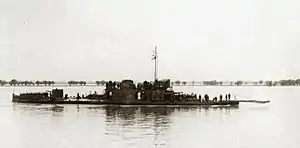Romanian landings in Bulgaria
The Romanian landings in Bulgaria were a decisive military action during the Second Balkan War. As Bulgaria was fighting both Greece and Serbia at that time, the Romanian invasion made the situation untenable for the Bulgarians, who were forced to ask for peace some two weeks later.
| Romanian landings in Bulgaria | |||||||
|---|---|---|---|---|---|---|---|
| Part of the Second Balkan War | |||||||
 Romanian river monitor | |||||||
| |||||||
| Belligerents | |||||||
|
|
| ||||||
| Commanders and leaders | |||||||
|
|
| ||||||
| Strength | |||||||
|
3 river monitors 6 torpedo boats 1 gunboat |
4 gunboats 4 motorboats | ||||||
| Casualties and losses | |||||||
| 6 gunboats scuttled | 4 gunboats scuttled | ||||||
Background
Bulgarian dissatisfaction following the share of spoils in the aftermath of the First Balkan War led to the souring of relations with its former allies, Serbia and Greece. Tensions escalated towards the end of June 1913 end June [O.S. mid-June] 1913, when Bulgaria launched attacks against both of its former allies, igniting the Second Balkan War.
Romania mobilised its army on 5 July [O.S. 23 June] 1913, with intention of seizing Southern Dobruja, and declared war on Bulgaria on 10 July [O.S. 28 June] 1913. In a diplomatic circular that said, "Romania does not intend either to subjugate the polity nor defeat the army of Bulgaria", the Romanian government endavoured to allay international concerns about its motives and about increased bloodshed.[1]
Romanian invasion
The Romanian warships which carried out the landings were concentrated at Corabia, on the Romanian side of the Danube, under the command of Admiral Eustațiu Sebastian. This group consisted of three monitors, six torpedo boats and the gunboat Grivița. The first landing was carried out on 14 July [O.S. 1 July] 1913, against no Bulgarian resistance. A second landing was carried out on the following day, and a pontoon bridge was also built. Foreign military strategists considered the bridge a "masterpiece of warfare", as the 950-metre-long (3,120 ft) structure was finished in 26 hours, requiring 125 pontoons.[2]
The Bulgarian naval forces on the Danube mainly consisted in four gunboats, with displacements of 400 to 600 tonnes (390 to 590 long tons; 440 to 660 short tons) and armed with two-to-four 75 mm (3.0 in) guns and two-to-four 47 mm (1.9 in) guns. There were also four motorboats.[3] Faced with the overwhelming superiority of the Romanian warships, the Bulgarians scuttled their four gunboats.[4]
Aftermath
The Romanian troops landed at Oryahovo, Gigen and Nikopol.[5] Unopposed, the Romanian ground forces advanced quickly, and on 23 July [O.S. 10 July] 1913, Romanian troops entered Vrazhdebna, a suburb just 11 km (7 mi) from Sofia.[6]
The lack of resistance to the Romanian invasion convinced the Ottomans to invade the territories just ceded to Bulgaria after the First Balkan War, the main objective of the invasion being the recovery of Edirne (Adrianople). The Ottomans advanced rapidly, against virtually no Bulgarian resistance.[7]
An armistice was agreed upon on 31 July [O.S. 18 July] 1913,[8] followed by the 10 August 10 August [O.S. 29 July] 1913, Treaty of Bucharest, which ended the war.
References
- Hall, Richard C. (2000). The Balkan Wars, 1912–1913: Prelude to the First World War. Routledge Publishing, p. 117
- Raymond Stănescu, Cristian Crăciunoiu, Marina română în primul război mondial, Modelism Publishing, 2000, pp. 35-37
- Raymond Stănescu, Cristian Crăciunoiu, Marina română în primul război mondial, Modelism Publishing, 2000, p. 55
- Spencer Tucker, Priscilla Mary Roberts,World War I: A Student Encyclopedia, p. 391
- Hall, Richard C. (2000). The Balkan Wars, 1912–1913: Prelude to the First World War. Routledge Publishing, p. 117
- Hall, Richard C. (2000). The Balkan Wars, 1912–1913: Prelude to the First World War. Routledge Publishing, p. 118
- Hall, Richard C. (2000). The Balkan Wars, 1912–1913: Prelude to the First World War. Routledge Publishing, p. 118
- Hall, Richard C. (2000). The Balkan Wars, 1912–1913: Prelude to the First World War. Routledge Publishing, pp. 123-124